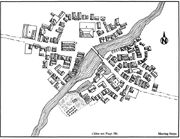
Mering Steps Map
Although there were precious few dwellers within the Ethir Onodló itself, a number of small settlements surrounded it. The largest of these was Imardhath (S. “Between Two Provinces“), the Mering Steps. This town was small but busy, situated on a bridge across the Mering Stream (S. “Glanhir"), and dominated by the large stone garrison-house. This was the seat and office of the Customs Master of the lower Onodló, a senior official appointed by the Cánor of Anórien and Calenardhon who was responsible for collecting taxes and pursuing the smugglers who plagued the region. Smuggling, the “Black Trade," had become something of a local tradition. The Customs Master and his garrison, together with the River Patrol, did a fairly good job of keeping order in the civilized lands,despite the widely spread population. Like all lands, these were hit badly by the Plague and few communities survived unscathed.In some cases the loss of life destroyed villages, hamlets and steadings, and handfuls of struggling survivors abandoned their former livelihoods to beg a share of others.In the lands north of the Entwash, it was quite possible to walk all day and not see a soul. Law enforcement had lapsed in the aftermath of the depopulating Plague, and many who were denied the ability to work the land turned to banditry. Outlaws flourished, but in the years since, most had either given up the hard life, or got captured and punished. Only a few doughty bands survived, raiding merchants and farms, stealing sheep and rustling cattle or horses, and conducting a little "black" trade themselves.
Mering Steps lay at a long-established crossing point over the Mering Stream. The "Steps" were actually stone piles sunk in the river, supporting a wooden bridge. The town itself was divided by the river, with the more important half on the westem ,Calenardhonian, side. Here, a number of large buildings, including the stone garrison-house, surrounded the Market Place. Erected four hundred years ago from strong White Mountain stone, it was a local marvel and a substantial hold. On the edge of the town was the Stewardry, a pair of long barns joined by a house. These barns held most of the taxes collected by the Customs Master, since locals prefered to pay in kind rather than coin. There were numerous shops, workshops, and residences on both sides of the river, many of them thatched, as reeds were in plentiful supply thanks to the proximity of the Lisgarath (S. “Reed-beds“) of the marshes.
Notes:[]
Original form in MERP:Imdorad = Imardhath
References:[]
- MERP:Mouths of the Entwash
